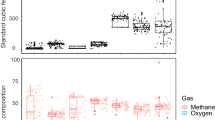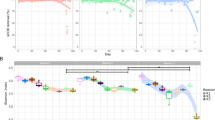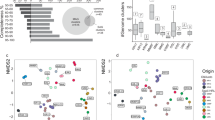Abstract
Microbes catalyze all major geochemical cycles on earth. However, the role of microbial traits and community composition in biogeochemical cycles is still poorly understood mainly due to the inability to assess the community members that are actually performing biogeochemical conversions in complex environmental samples. Here we applied a polyphasic approach to assess the role of microbial community composition in modulating methane emission from a riparian floodplain. We show that the dynamics and intensity of methane consumption in riparian wetlands coincide with relative abundance and activity of specific subgroups of methane-oxidizing bacteria (MOB), which can be considered as a minor component of the microbial community in this ecosystem. Microarray-based community composition analyses demonstrated linear relationships of MOB diversity parameters and in vitro methane consumption. Incubations using intact cores in combination with stable isotope labeling of lipids and proteins corroborated the correlative evidence from in vitro incubations demonstrating γ-proteobacterial MOB subgroups to be responsible for methane oxidation. The results obtained within the riparian flooding gradient collectively demonstrate that niche partitioning of MOB within a community comprised of a very limited amount of active species modulates methane consumption and emission from this wetland. The implications of the results obtained for biodiversity–ecosystem functioning are discussed with special reference to the role of spatial and temporal heterogeneity and functional redundancy.
Similar content being viewed by others
Log in or create a free account to read this content
Gain free access to this article, as well as selected content from this journal and more on nature.com
or
Accession codes
References
Bell T, Gessner MO, Griffiths RI, McLaren J, Morin PJ, van der Heijden M et al (2009). Microbial biodiversity and ecosystem functioning under controlled conditions and in the wild. In: Naeem SB, Bunker DE, Hector A, Loreau M, Perrings C (eds) Biodiversity, Ecosystem Functioning, and Human Wellbeing: An Ecological and Economic Perspective. Oxford University Press: Oxford, pp 121–133.
Belova SE, Baani M, Suzina NE, Bodelier PLE, Liesack W, Dedysh SN . (2011). Acetate utilization as a survival strategy of peat-inhabiting Methylocystis spp. Environ Microbiol Rep 3: 36–46.
Benndorf D, Balcke GU, Harms H, von Bergen M . (2007). Functional metaproteome analysis of protein extracts from contaminated soil and groundwater. ISME J 1: 224–234.
Benndorf D, Vogt C, Jehmlich N, Schmidt Y, Thomas H, Woffendin G et al (2009). Improving protein extraction and separation methods for investigating the metaproteome of anaerobic benzene communities within sediments. Biodegradation 20: 737–750.
Bloom AA, Palmer PI, Fraser A, Reay DS, Frankenberg C . (2010). Large-scale controls of methanogenesis inferred from methane and gravity spaceborne data. Science 327: 322–325.
Bodelier PLE, Hahn AP, Arth IR, Frenzel P . (2000). Effects of ammonium-based fertilisation on microbial processes involved in methane emission from soils planted with rice. Biogeochemistry 51: 225–257.
Bodelier PLE . (2011). Toward understanding, managing, and protecting microbial ecosystems. Front Microbiol 2: 80.
Bodelier PLE, Bar-Gilissen MJB, Meima-Franke M, Hordijk K . (2012). Structural and functional response of methane-consuming microbial communities to different flooding regimes in riparian soils. Ecol Evol 2: 106–127.
Bodelier PLE, Bar-Gillisen MJB, Hordijk K, Sinninghe Damsté JSS, Rijpstra WIC, Geenevasen JAJ et al (2009). A reanalysis of phospholipid fatty acids as ecological biomarkers for methanotrophic bacteria. ISME J 3: 606–616.
Boden R, Cunliffe M, Scanlan J, Moussard H, Kits KD, Klotz MG et al (2011). Complete genome sequence of the aerobic marine methanotroph methylomonas methanica MC09. J Bacteriol 193: 7001–7002.
Boschker HTS, Nold SC, Wellsbury P, Bos D, de Graaf W, Pel R et al (1998). Direct linking of microbial populations to specific biogeochemical processes by C-13-labelling of biomarkers. Nature 392: 801–805.
Bousquet P, Ciais P, Miller JB, Dlugokencky EJ, Hauglustaine DA, Prigent C et al (2006). Contribution of anthropogenic and natural sources to atmospheric methane variability. Nature 443: 439–443.
Caliman A, Pires AF, Esteves FA, Bozelli RL, Farjalla VF . (2010). The prominence of and biases in biodiversity and ecosystem functioning research. Biodivers Conserv 19: 651–664.
Cardinale BJ, Srivastava DS, Duffy JE, Wright JP, Downing AL, Sankaran M et al (2006). Effects of biodiversity on the functioning of trophic groups and ecosystems. Nature 443: 989–992.
Cardinale BJ . (2011). Biodiversity improves water quality through niche partitioning. Nature 472: 86–89.
Cardinale BJ, Duffy JE, Gonzalez A, Hooper DU, Perrings C, Venail P et al (2012). Biodiversity loss and its impact on humanity. Nature 486: 59–67.
Chen Y, Dumont MG, Cebron A, Murrell JC . (2007). Identification of active methanotrophs in a landfill cover soil through detection of expression of 16S rRNA and functional genes. Environ Microbiol 9: 2855–2869.
Chourey K, Jansson J, VerBerkmoes N, Shah M, Chavarria KL, Tom LM et al (2010). Direct cellular lysis/protein extraction protocol for soil metaproteomics. J Proteome Res 9: 6615–6622.
Cockell CS, Jones HL . (2009). Advancing the case for microbial conservation. Oryx 43: 520–526.
Conrad R . (2007). Microbial ecology of methanogens and methanotrophs. Adv Agron 96: 1–63.
Dam B, Dam S, Kube M, Reinhardt R, Liesack W . (2012). Complete genome sequence of Methylocystis sp strain SC2, an aerobic methanotroph with high-affinity methane oxidation potential. J Bacteriol 194: 6008–6009.
Daniell TJ, Davidson J, Alexander CJ, Caul S, Roberts DM . (2012). Improved real-time PCR estimation of gene copy number in soil extracts using an artificial reference. J Microbiol Methods 91: 38–44.
Dedysh SN, Knief C, Dunfield PF . (2005). Methylocella species are facultatively methanotrophic. J Bacteriol 187: 4665–4670.
Dedysh SN, Belova SE, Bodelier PLE, Smirnova KV, Khmelenina VN, Chidthaisong A et al (2007). Methylocystis heyeri sp nov., a novel type II methanotrophic bacterium possessing ‘signature’ fatty acids of type I methanotrophs. Int J Syst Evol Microbiol 57: 472–479.
del Cerro C, Garcia JM, Rojas A, Tortajada M, Ramon D, Galan B et al (2012). Genome sequence of the methanotrophic poly-beta-hydroxybutyrate producer Methylocystis parvus OBBP. J Bacteriol 194: 5709–5710.
Dumont MG, Pommerenke B, Casper P, Conrad R . (2011). DNA-, rRNA- and mRNA-based stable isotope probing of aerobic methanotrophs in lake sediment. Environ Microbiol 13: 1153–1167.
Dunfield PF, Yuryev A, Senin P, Smirnova AV, Stott MB, Hou SB et al (2007). Methane oxidation by an extremely acidophilic bacterium of the phylum Verrucomicrobia. Nature 450: 879–882.
Ettwig KF, Butler MK, Le Paslier D, Pelletier E, Mangenot S, Kuypers MMM et al (2010). Nitrite-driven anaerobic methane oxidation by oxygenic bacteria. Nature 464: 543–548.
Falkowski PG, Fenchel T, Delong EF . (2008). The microbial engines that drive Earth’s biogeochemical cycles. Science 320: 1034–1039.
Freitag TE, Toet S, Ineson P, Prosser JI . (2010). Links between methane flux and transcriptional activities of methanogens and methane oxidizers in a blanket peat bog. FEMS Microbiol Ecol 73: 157–165.
Gans J, Wolinsky M, Dunbar J . (2005). Computational improvements reveal great bacterial diversity and high metal toxicity in soil. Science 309: 1387–1390.
Graef C, Hestnes AG, Svenning MM, Frenzel P . (2011). The active methanotrophic community in a wetland from the High Arctic. Environ Microbiol Rep 3: 466–472.
Griffith GW . (2012). Do we need a global strategy for microbial conservation? Trends Ecol Evol 27: 1–2.
Hillebrand H, Matthiessen B . (2009). Biodiversity in a complex world: consolidation and progress in functional biodiversity research. Ecol Lett 12: 1405–1419.
Ho A, Lüke C, Cao ZH, Frenzel P . (2011). Ageing well: methane oxidation and methane oxidizing bacteria along a chronosequence of 2000 years. Environ Microbiol Rep 3: 738–743.
Ho A, Kerckhof FM, Lüke C, Reim A, Krause SMB, Boon N et al (2013). Conceptualizing functional traits and ecological characteristics of methane-oxidizing bacteria as life strategies. Environ Microbiol Rep 5: 335–345.
Holmes AJ, Costello A, Lidstrom ME, Murrell JC . (1995). Evidence that particulate methane monooxygenase and ammonia monooxygenase may be evolutionary related. FEMS Microbiol Lett 132: 203–208.
Jahnke LL, Summons RE, Hope JM, des Marais DJ . (1999). Carbon isotopic fractionation in lipids from methanotrophic bacteria II: the effects of physiology and environmental parameters on the biosynthesis and isotopic signatures of biomarkers. Geochim Cosmochim Acta 63: 79–93.
Jehmlich N, Schmidt F, Taubert M, Seifert J, Bastida F, von Bergen M et al (2010). Protein-based stable isotope probing. Nat Protoc 5: 1957–1966.
Kai FM, Tyler SC, Randerson JT, Blake DR . (2011). Reduced methane growth rate explained by decreased Northern Hemisphere microbial sources. Nature 476: 194–197.
Keiblinger KM, Wilhartitz IC, Schneider T, Roschitzki B, Schmid E, Eberl L et al (2012). Soil metaproteomics —comparative evaluation of protein extraction protocols. Soil Biol Biochem 54: 14–24.
Kemnitz D, Chin KJ, Bodelier P, Conrad R . (2004). Community analysis of methanogenic archaea within a riparian flooding gradient. Environ Microbiol 6: 449–461.
Khadem AF, Pol A, Wieczorek A, Mohammadi SS, Francoijs K-J, Stunnenberg HG et al (2011). Autotrophic methanotrophy in Verrucomicrobia: Methylacidiphilum fumariolicum SolV uses the Calvin–Benson–Bassham cycle for carbon dioxide fixation. J Bacteriol 193: 4438–4446.
Kleiveland CR, Hult LTO, Kuczkowska K, Jacobsen M, Lea T, Pope PB . (2012). Draft genome sequence of the methane-oxidizing bacterium Methylococcus capsulatus (Texas). J Bacteriol 194: 6626–6626.
Kolb S, Knief C, Stubner S, Conrad R . (2003). Quantitative detection of methanotrophs in soil by novel pmoA-targeted real-time PCR assays. Appl Environ Microbiol 69: 2423–2429.
Kuramae EE, Yergeau E, Wong LC, Pijl AS, van Veen JA, Kowalchuk GA . (2012). Soil characteristics more strongly influence soil bacterial communities than land-use type. FEMS Microbiol Ecol 79: 12–24.
Lennon JT, Jones SE . (2011). Microbial seed banks: the ecological and evolutionary implications of dormancy. Nat Rev Microbiol 9: 119–130.
Levine UY, Teal TK, Robertson GP, Schmidt TM . (2011). Agriculture’s impact on microbial diversity and associated fluxes of carbon dioxide and methane. ISME J 5: 1683–1691.
Loreau M . (2010). Linking biodiversity and ecosystems: towards a unifying ecological theory. Philos Trans R Soc Lond B Biol Sci 365: 49–60.
Lüke C, Frenzel P . (2011). Potential of pmoA amplicon pyrosequencing for methanotroph diversity studies. Appl Environ Microbiol 77: 6305–6309.
McDonald IR, Bodrossy L, Chen Y, Murrell JC . (2008). Molecular ecology techniques for the study of aerobic methanotrophs. Appl Environ Microbiol 74: 1305–1315.
Mohanty SR, Bodelier PLE, Floris V, Conrad R . (2006). Differential effects of nitrogenous fertilizers on methane-consuming microbes in rice field and forest soils. Appl Environ Microbiol 72: 1346–1354.
Monard C, Vandenkoornhuyse P, Le Bot B, Binet F . (2011). Relationship between bacterial diversity and function under biotic control: the soil pesticide degraders as a case study. ISME J 5: 1048–1056.
Mora C, Tittensor DP, Adl S, Simpson AGB, Worm B . (2011). How many species are there on earth and in the ocean? PLoS Biol 9: e1001127.
Musat N, Halm H, Winterholler B, Hoppe P, Peduzzi S, Hillion F et al (2008). A single-cell view on the ecophysiology of anaerobic phototrophic bacteria. Proc Natl Acad Sci USA 105: 17861–17866.
Neufeld JD, Wagner M, Murrell JC . (2007). Who eats what, where and when? Isotope-labelling experiments are coming of age. ISME J 1: 103–110.
Op den Camp HJM, Islam T, Stott MB, Harhangi HR, Hynes A, Schouten S et al (2009). Environmental, genomic and taxonomic perspectives on methanotrophic Verrucomicrobia. Environ Microbiol Rep 1: 293–306.
Pan Y, Bodrossy L, Frenzel P, Hestnes A, Krause SBM, Lüke C et al (2010). Impacts of inter- and intralaboratory variations on the reproducibility of microbial community analyses. Appl Environ Microbiol 76: 7451–7458.
Paszczynski AJ, Paidisetti R, Johnson AK, Crawford RL, Colwell FS, Green T et al (2011). Proteomic and targeted qPCR analyses of subsurface microbial communities for presence of methane monooxygenase. Biodegradation 22: 1045–1059.
Perkins DN, Pappin DJC, Creasy DM, Cottrell JS . (1999). Probability-based protein identification by searching sequence databases using mass spectrometry data. Electrophoresis 20: 3551–3567.
Pester M, Bittner N, Deevong P, Wagner M, Loy A . (2010). A ‘rare biosphere’ microorganism contributes to sulfate reduction in a peatland. ISME J 4: 1591–1602.
Peter H, Beier S, Bertilsson S, Lindstrom ES, Langenheder S, Tranvik LJ . (2011). Function-specific response to depletion of microbial diversity. ISME J 5: 351–361.
Pol A, Heijmans K, Harhangi HR, Tedesco D, Jetten MSM, den Camp H . (2007). Methanotrophy below pH1 by a new Verrucomicrobia species. Nature 450: 874–878.
Seifert J, Taubert M, Jehmlich N, Schmidt F, Volker U, Vogt C et al (2012). Protein-based stable isotope probing (protein-SIP) in functional metaproteomics. Mass Spectrom Rev 31: 683–697.
Semrau JD, DiSpirito AA, Yoon S . (2010). Methanotrophs and copper. Fems Microbiol Rev 34: 496–531.
Semrau JD, DiSpirito AA, Vuilleumier S . (2011). Facultative methanotrophy: false leads, true results, and suggestions for future research. FEMS Microbiol Lett 323: 1–12.
Sharp CE, Stott MB, Dunfield PF . (2012). Detection of autotrophic verrucomicrobial methanotrophs in a geothermal environment using stable isotope probing. Front Microbiol 3: 303–303.
Spahni R, Wania R, Neef L, van Weele M, Pison I, Bousquet P et al (2011). Constraining global methane emissions and uptake by ecosystems. Biogeosciences 8: 1643–1665.
Steenbergh AK, Meima MM, Kamst M, Bodelier PLE . (2010). Biphasic kinetics of a methanotrophic community is a combination of growth and increased activity per cell. FEMS Microbiol Ecol 71: 12–22.
Stein LY, Yoon S, Semrau JD, DiSpirito AA, Crombie A, Murrell JC et al (2010). Genome sequence of the obligate methanotroph Methylosinus trichosporium strain OB3b. J Bacteriol 192: 6497–6498.
Stein LY, Bringel F, DiSpirito AA, Han S, Jetten MSM, Kalyuzhnaya MG et al (2011). Genome sequence of the methanotrophic Alphaproteobacterium Methylocystis sp strain Rockwell (ATCC 49242). J Bacteriol 193: 2668–2669.
Stein LY, Roy R, Dunfield PF . (2012) Aerobic Methanotrophy and Nitrification: Processes and Connections. eLS. John Wilet & Sons Ltd.: Chichester.
Taubert M, Jehmlich N, Vogt C, Richnow HH, Schmidt F, von Bergen M et al (2011). Time resolved protein-based stable isotope probing (protein-SIP) analysis allows quantification of induced proteins in substrate shift experiments. Proteomics 11: 2265–2274.
Templeton AS, Chu KH, Alvarez-Cohen L, Conrad ME . (2006). Variable carbon isotope fractionation expressed by aerobic CH4-oxidizing bacteria. Geochim Cosmochim Acta 70: 1739–1752.
Wang J, Krause S, Muyzer G, Meima-Franke M, Laanbroek HJ, Bodelier PLE . (2012). Spatial patterns of iron- and methane-oxidizing bacterial communities in an irregularly flooded, riparian wetland. Front Microbiol 3: 64–64.
Ward N, Larsen O, Sakwa J, Bruseth L, Khouri H, Durkin AS et al (2004). Genomic insights into methanotrophy: the complete genome sequence of Methylococcus capsulatus (Bath). PLoS Biol 2: 1616–1628.
Wessen E, Hallin S, Philippot L . (2010). Differential responses of bacterial and archaeal groups at high taxonomical ranks to soil management. Soil Biol Biochem 42: 1759–1765.
Whitman WB, Coleman DC, Wiebe WJ . (1998). Prokaryotes: the unseen majority. Proc Natl Acad Sci USA 95: 6578–6583.
Wohl DL, Arora S, Gladstone JR . (2004). Functional redundancy supports biodiversity and ecosystem function in a closed and constant environment. Ecology 85: 1534–1540.
Yang S, Matsen JB, Konopka M, Green-Saxena A, Clubb J, Sadilek M et al (2013). Global molecular analyses of methane metabolism in methanotrophic Alphaproteobacterium, Methylosinus trichosporium OB3b. Part II. Metabolomics and 13C-labeling study. Front Microbiol 4: 70.
Acknowledgements
We thank Foundation ‘De Ark’ for permitting us to take samples at ‘Ewijkse Waard.’ This study was a part of the ESF — Eurodiversity program (ERAS-CT-2003-98049, sixth EU framework program) and was financially supported by grants from the Netherlands Organization for Scientific Research (NWO; grant no. 855.01.108). This publication is publication no. 5451 of the Netherlands Institute of Ecology.
Author information
Authors and Affiliations
Corresponding author
Additional information
Supplementary Information accompanies this paper on The ISME Journal website
Supplementary information
Rights and permissions
About this article
Cite this article
Bodelier, P., Meima-Franke, M., Hordijk, C. et al. Microbial minorities modulate methane consumption through niche partitioning. ISME J 7, 2214–2228 (2013). https://doi.org/10.1038/ismej.2013.99
Received:
Revised:
Accepted:
Published:
Issue date:
DOI: https://doi.org/10.1038/ismej.2013.99
Keywords
This article is cited by
-
Type I methanotrophs dominated methane oxidation and assimilation in rice paddy fields by the consequence of niche differentiation
Biology and Fertility of Soils (2024)
-
Synergy effects of Methylomonas koyamae and Hyphomicrobium methylovorum under methanethiol stress
Applied Microbiology and Biotechnology (2023)
-
Sequencing introduced false positive rare taxa lead to biased microbial community diversity, assembly, and interaction interpretation in amplicon studies
Environmental Microbiome (2022)
-
Linking transcriptional dynamics of CH4-cycling grassland soil microbiomes to seasonal gas fluxes
The ISME Journal (2022)
-
The anaerobic oxidation of methane driven by multiple electron acceptors suppresses the release of methane from the sediments of a reservoir
Journal of Soils and Sediments (2022)



